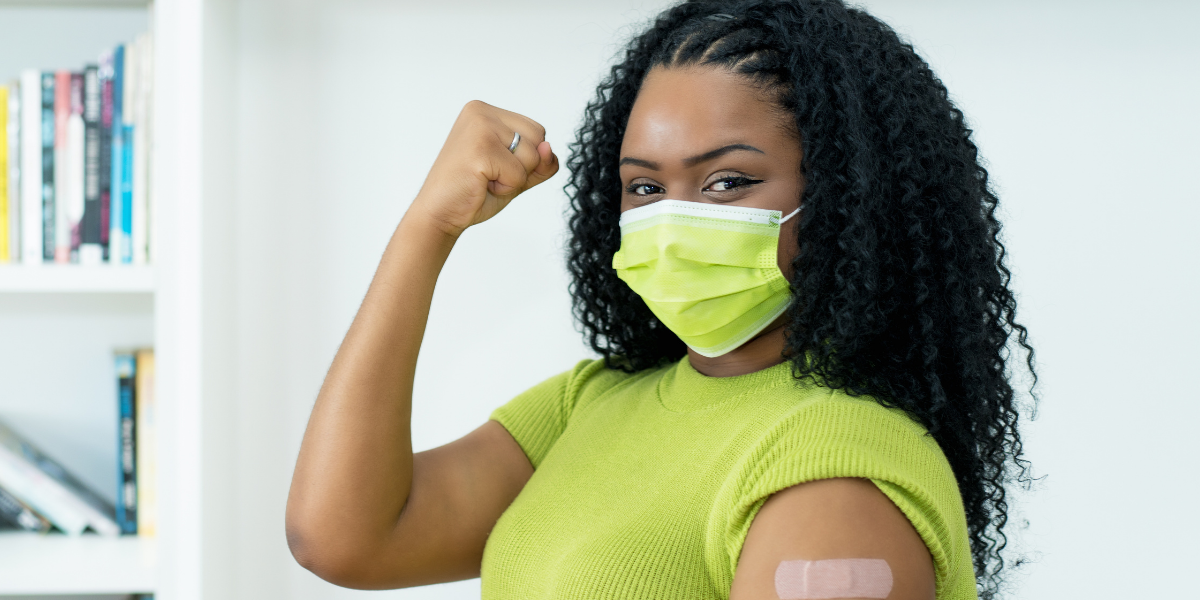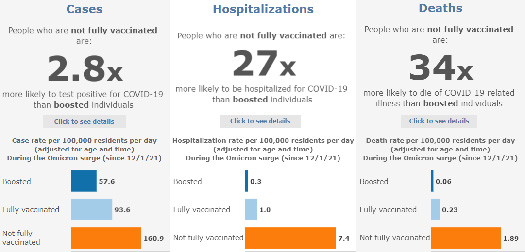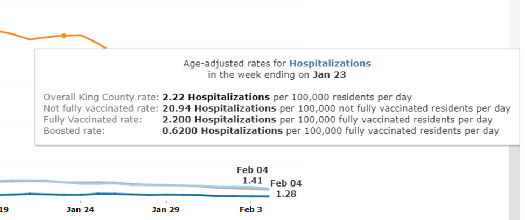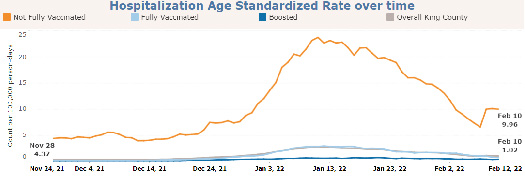Data Dashboard Shows How Vaccinated and Boosted People have Weathered the Omicron Surge

King County residents who have gotten a booster dose of the COVID-19 vaccines are far less likely to get seriously ill than people who aren’t fully vaccinated, according to a newly updated data tool from Public Health—Seattle & King County.
Public Health has been tracking how well the vaccines are protecting King County residents against the worst outcomes of COVID-19 – hospitalizations and deaths. The data reported on the Outcomes by Vaccination Status dashboard has shown consistently that the vaccines are working.
Now, the dashboard has incorporated booster doses, and the benefits are even clearer: An additional dose gives you a huge boost in protection.
“The booster dose is an essential part of the vaccine series,” said Dr. Jeff Duchin, Health Officer, Public Health—Seattle & King County. “Everyone who is eligible for a booster should get it as soon as they can to be sure they are as protected as possible against severe CoV-19.”
A booster dose is recommended for:
- Everyone 12 years and older who has completed a Pfizer vaccine series
- Everyone 18 years and older who has completed a Moderna or Johnson & Johnson vaccine series.
Boosters should be administered at least five months after the second shot of Moderna or Pfizer or two months after receiving one dose of Johnson & Johnson. People who are moderately or severely immunocompromised also need an additional primary series dose before their booster and may receive boosters sooner than people who are not.
Boosters are keeping people out of the hospital
People who are fully vaccinated and boosted have weathered the Omicron surge with a much lower risk of getting severely ill.

Dashboard is updated daily. Data since 12/1/21, shown as of Feb. 22, 2022.
In the period from December 1, 2021 through mid-February 2022, as the Omicron variant became predominant, people who were not fully vaccinated and not boosted were 26 times more likely to be hospitalized due to COVID-19 (as of February 10, 2022). Those individuals’ risk of dying from COVID-19 was 36 times higher than people who were both fully vaccinated and boosted.
Just getting the primary vaccine series, without a booster, provided significant protection against hospitalization and death. But the benefit is much larger with the booster.
Vaccines’ main job is to prevent the severe illness that leads to hospitalizations and deaths. But it is also important to note that getting vaccinated and boosted decreases your risk of getting COVID-19 at all. During Omicron, people who were not fully vaccinated were nearly three times more likely to test positive for COVID-19 than people who are fully vaccinated and boosted.
A snapshot during Omicron

This snapshot from Jan. 23 shows how people who are fully vaccinated and boosted have much lower rates of hospitalization.
Let’s look at the hospitalizations data for a single day to understand the benefit of getting the booster dose. On Sunday, January 23, 2022, hospitalization rates were near their pandemic peak. On that day, King County hospitals issued an urgent call to the public to help reduce the pressure on our healthcare system.
The data dashboard shows that on that day, the rate of hospitalizations for people who were not fully vaccinated was 21 per 100,000 residents.
For people who were fully vaccinated and boosted, the rate was just 0.6 per 100,000 residents.
People who were fully vaccinated but not yet boosted were being hospitalized at a rate of 2.2 per 100,000 residents.
The dashboard measures the difference in the rates of cases, hospitalizations, and deaths for people of different vaccine statuses, rather than simply comparing, say, how many people hospitalized from COVID are vaccinated versus not vaccinated. We look at the relative risk as the best way to understand how vaccines and boosters affect your likelihood of getting very sick.
As more people are vaccinated, we expect a higher proportion of cases to occur among vaccinated people. (If everyone were vaccinated, the only COVID-19 cases, hospitalizations, and deaths would be among vaccinated people.) To compare the risk of severe COVID-19 for unvaccinated, vaccinated, and boosted people, we need to look at rates of disease. This is why our graphs show rates and not the proportions—rates tell us about risk.
Boosters are free and widely available

Hospitalization age-adjusted rate over time, as of Feb. 22, 2022.
Public Health teams have been administering COVID-19 vaccines, including boosters, at community-based events and pop-up clinics all over King County. Demand has been growing for these clinics. Public Health has nearly 50 scheduled in February alone (some of these are closed to the public – for a list of free, open events, please see this schedule of vaccine pop-ups.)
These events take place at community centers, public libraries, faith-based organizations, and other public places.
“It’s rewarding to see people respond and seeing people standing up and getting excited about getting boosted,” said Ben Meana, Public Health’s operations lead for community vaccination events.
Meana and his team of eight have been doing vaccine outreach in the community since the COVID-19 vaccines first became available. He recalls a particular clinic, held in late January at a thrift store in Burien. A casual shopper there noticed the clinic signs and popped her head in.
“She said, ‘are you guys doing boosters?’ We said, ‘yes, come on in!’” said Meana. “She said she’d been trying so long to find a booster appointment, and she was so grateful we were there. Got her shot within 10 minutes. We were also handing out test kits there. You could see her appreciation of how seamless and easy it was. It’s rewarding to see, and it fills up our cups.”
Where to get your booster
King County residents have done an exceptional job protecting themselves and our community by completing their primary vaccine series. As of early February, 87 percent of residents aged 12 and older are fully vaccinated—one of the highest rates of any urban area in the United States.
By comparison, about 53 percent of residents aged 12 and older have gotten their booster. That means that nearly half of the eligible people in King County are not yet getting the maximum protection that vaccines provide. One highlight is that older age groups have good coverage with boosters: Over 80 percent of King County residents over age 65 are fully vaccinated and boosted.
Getting a booster is easy and free. There are plenty of drop-in or scheduled appointments for both boosters and primary vaccination at sites in Auburn, West Seattle, Rainier Beach, and Shoreline. For more information and additional locations: kingcounty.gov/vaccine
Contributor Gabriel Spitzer is a communications specialist with Public Health—Seattle & King County.
Originally published in Public Health Insider on February 23, 2022. Re-posted in the March issue of AgeWise King County.
![Aging & Disability Services for Seattle & King County [logo]](https://www.agingkingcounty.org/wp-content/themes/sads/images/seattle-ads-logo.png)